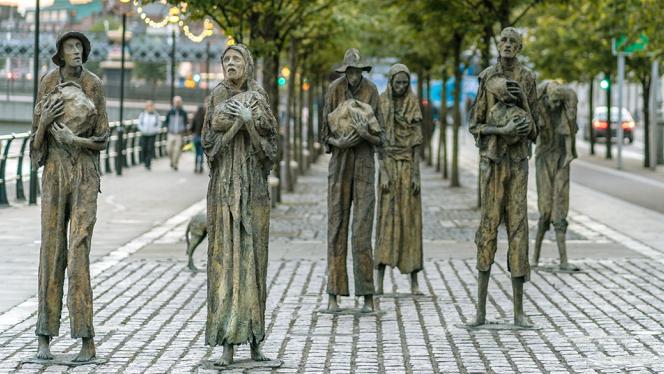Friday 15 November 2024
The use and misuse of the word Famine

International organisations, news houses and corrupt governments are not helping us find sustainable solutions to food insecurity
International media are sounding the alarm of an imminent famine, which will wipe out millions within weeks, in the Horn of Africa. It is an alarm that is repeated regularly on news channel bulletins. The clips often begin with UN statements calling on humanitarian organisations to intervene and address the imminent humanitarian catastrophe, followed by confirmations (and appeals) from WFP offices in Geneva, New York, and Nairobi of the seriousness of the situation and the necessity of donating immediately to prevent catastrophe, all the while accompanied by a stream of harrowing images and statistics.
The images of children, naked, barefoot, with pale eyes and protruding bones, carries an inexhaustible attraction power in international media. While there are severe food crises in many parts of the world, they tend to lack the ideological investment that is reserved for the humanitarian crises that have plagued the Horn of Africa countries since the Ethiopian famine in 1983, and the two disastrous Somali famines in 1992 and 2011.
Generally, these media reports do not indicate the causes of the famine. They tend not to examine whether it might be climate change and resulting droughts or low rainfall. This is especially important in the Horn of Africa as the economies of the region rely heavily on agriculture and livestock grazing for more than 75% of their population. It is peculiar that countries whose main exports are food products suffer food insecurity, indicating that it isn’t due to lack. They also omit the disastrous repercussions of the COVID-19 pandemic and the Ukrainian crisis on the economies of these countries, especially in terms of the global grain and fuel supplies shortage, the rise in shipping costs and commodity prices, and the diversion in international humanitarian aid to Ukraine.
This ludicrous neglect of the crises’ causes and the tendency of humanitarian organisations to inflate the victims’ numbers is hardly innocent, for they serve a huge market of humanitarian and charitable organisations, and the media that constantly feed on these disasters for their output. A large body of literature has deconstructed this ideological image of famine and disaster, such as Michael Maren’s (a former Peace Corps volunteer and USAID worker) book “The Road to Hell,” which described aid and charity work in Somalia “as an industry, as religion, as a self-serving system that sacrifices its own practitioners and intended beneficiaries in order that it may survive and grow.” In some cases, Maren powerfully argues, aid can be “positively evil.”
This approach presents the Horn of Africa as a place where disasters occur naturally and predictably. Humans just happen to perish in these inhospitable and warn-torn desert territories. For example, the classification of a famine is very technical, and is determined by three basic criteria according to the Integrated Food Security Phase Classification (IPC) launched in 2004: at least 20% of households in an area experience severe food shortages; that more than 30% of children under the age of five in the sample group suffer from acute malnutrition; at least two people out of every 10,000 die each day due to food shortages.
So, what about the current situation in Somalia? There are no governmental or international statistics to determine if there is a famine, nevertheless the media and UN bodies do not refrain from using the famine classification. Two famines have already been declared since the classification came into use and both in the Horn of Africa region: Somalia in 2011 and South Sudan in 2017. The classifying a famine of course cannot be as precise as the IPC outlines in its criteria, raising questions about whether the word is thrown around to increase donations.
Obviously, the food crisis is not limited to these countries; but in the Horn of Africa, it is linked to a broader context related to a lack of development. Aid then doesn’t treat the cause but the symptom. One estimate stated that aid to the continent amounted to $1.2 trillion in the last three decades alone, with donors spending more than a thousand dollars per capita during that period. In the same period, the average income of sub-Saharan Africans increased only by $350. In addition to the fact that the aid was not distributed equally among the countries of the continent, few African countries achieved the rapid economic growth seen in several Asian countries (South Korea, China, Vietnam, Indonesia, and India) during the same period.
The question remains: why does aid fail to achieve the economic transformation that has been achieved elsewhere? Has western aid promoted or hindered local development? Greg Mills, director of the South African Brenthurst Foundation, points says in his book, Expensive Poverty: Why Aid Fails and How It Can Work, to three basic reasons behind the failure of aid in achieving the expected transformation in Africa: weak state institutions, a consequence of historical colonial legacy; rampant corruption due to a lack of judicious and accountable political systems; donors’ interest in short-term goals.
Somalia appears to be the place where this equation is embodied more than any other country, as three decades of aid have failed to make any significant difference in any of the above metrics. The so-called War on Terror also failed to give the Somali state the capacity it needs to provide services to its citizens and guarantee their safety.
This is primarily a political failure and is not related to economics or scarce resources. To date, there are no governmental institutions in Somalia that can be held accountable for spending decisions. The corrupt political elites controlling the political process feel that they can dispose of public funds and escape accountability immediately after their mandate ends. Western humanitarian aid has a long history of corruption and complicity with Somalia's regimes, starting with Siad Barre’s authoritarian regime, down to the post-war elites. The humanitarian sector is characterised by a high degree of ‘projectisation’, with the connivance of international bodies and donor agendas. The conflict with jihadists further exacerbates these problems, thereby completing the corruption cycle, making donors choose to focus on short-term projects. Thus, most of the money is hastily directed at hollow projects. Many times, aid ends up in the hands of Al-Shabaab, either through taxes imposed on humanitarian agencies, or through settlements. Indeed, international bodies were involved in allocating percentages of aid to the Al-Shabaab Militant group in exchange for securing roads (which the UN and continental forces present in the country failed to achieve), according to a report issued by ICG in 2022.
Hence, Somalia's real crisis lies in the absence of cohesive governance institutions and effective mechanisms for coordinating regional solutions to common challenges. Aid passes through corrupt government agencies and bodies in Mogadishu and does not typically reach those affected in regions outside the direct rule of the internationally recognised Somali government, which receives advice from retired experts who prattle about exaggerated reports and statistics in their luxurious offices in Nairobi.
So, an appropriate formula must be found to reach those truly affected, in different regions and rural areas, such as direct coordination with local communities and active civil society bodies. The other side of the crisis is no less problematic, which is the media and the humanitarian institutions that continue to invest in, and exaggerate, famine. If this relational structure is not dismantled in humanitarian, governmental and media institutions, Somalia and the Horn of Africa countries will continue to grab headlines of humanitarian disasters as if it were an inevitable fate instead of focusing attention on durable solutions.










